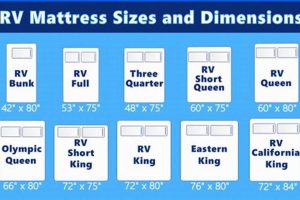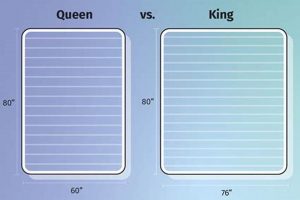A large innerspring bed designed for couples or individuals who desire ample personal space while sleeping. These bedding systems utilize coil springs for support and cushioning, and are constructed to fit within the dimensions typically associated with the largest standard mattress size available. The overall dimensions provide generous surface area compared to smaller options.
Such large-format, innerspring designs offer benefits, including reduced motion transfer when sharing the bed with a partner, which minimizes sleep disruption. The expanded sleep surface caters to individuals who tend to move around during the night. Historically, innerspring mattresses have been a dominant design in the bedding industry, and the introduction of larger sizes addressed the evolving consumer preference for increased comfort and space.
The following sections will explore factors influencing the purchase decision, including coil type, material composition, and considerations for selecting the most appropriate model. Furthermore, maintenance guidelines and comparisons with alternative mattress technologies will be discussed.
Guidance for Selecting a Large Innerspring Bedding System
The following points offer considerations for evaluating and selecting a large innerspring bedding system, intended to enhance comfort and longevity.
Tip 1: Evaluate Coil Type. The type of coil system significantly impacts support and motion isolation. Pocketed coils, where each spring is encased in fabric, minimize motion transfer more effectively than interconnected coil systems. Bonnell coils are a more traditional, durable, and economical choice, though they may transfer motion more readily.
Tip 2: Assess Coil Gauge. Coil gauge refers to the thickness of the wire used in the springs. A lower gauge number indicates a thicker, firmer coil. Individuals requiring greater support should consider a lower gauge, while those preferring a softer feel may opt for a higher gauge.
Tip 3: Examine Upholstery Layers. The comfort layers above the coils contribute significantly to the overall feel of the bedding system. These layers may consist of materials such as memory foam, latex, or fiberfill. Consider the density and composition of these materials, as they influence pressure relief and temperature regulation.
Tip 4: Investigate Edge Support. Edge support, often achieved through reinforced coils or foam encasement, prevents sagging at the edges of the bedding system. Adequate edge support maximizes the usable sleep surface and facilitates easier entry and exit from the bed.
Tip 5: Consider Foundation Compatibility. Ensure the chosen foundation is designed to support the weight and dimensions of the bedding system. A sturdy foundation is essential for maintaining the structural integrity of the mattress and preventing premature wear.
Tip 6: Inspect Quilting and Ticking. The quilting pattern and ticking material affect the surface feel and durability of the mattress. Tight quilting can provide a firmer surface, while looser quilting may offer a softer feel. Breathable ticking materials contribute to temperature regulation.
Tip 7: Check Warranty and Return Policy. Review the manufacturer’s warranty for defects in materials and workmanship. A generous return policy allows for a trial period to assess comfort and suitability before committing to the purchase.
Careful attention to coil type, upholstery layers, and foundation compatibility optimizes the selection process. Prioritization of these details maximizes the potential for a comfortable and supportive sleep environment.
The subsequent section concludes the analysis, summarizing key considerations for maximizing the lifespan of the selected bedding system.
1. Dimensions
The dimensions of a large innerspring sleeping platform are a critical defining characteristic, directly impacting its suitability for various users and spaces. The standardized measurements, typically 76 inches in width and 80 inches in length, dictate the amount of surface area available for occupants. This, in turn, influences sleeping comfort, particularly for couples or individuals who prefer ample personal space. A larger sleeping surface reduces the likelihood of sleep disturbance caused by a partner’s movements. As an example, a couple sharing a smaller full-size mattress may experience frequent awakenings due to proximity and motion transfer, a problem mitigated by the increased dimensions of a standard offering.
Furthermore, the dimensions directly correlate with bedroom size requirements. A small bedroom may not adequately accommodate a large innerspring mattress without compromising available floor space and maneuverability. Conversely, in a larger bedroom, a standard mattress may appear disproportionately small, diminishing the aesthetic appeal of the room. Therefore, prior to purchasing a large innerspring bedding system, precise measurements of the intended space are essential to ensure a proper fit and prevent logistical challenges during delivery and setup. These dimensional considerations also extend to related bedding accessories, such as sheets and bed frames, which must be specifically sized to accommodate the large innerspring.
In summary, the dimensions of this type of mattress are integral to its function and suitability. Proper consideration of these measurements in relation to both the user’s needs and the physical space available is essential for maximizing comfort and ensuring a harmonious integration of the bedding system within the bedroom environment. Failure to account for these dimensional constraints can result in user dissatisfaction and practical difficulties.
2. Coil System
The coil system within a large innerspring bedding platform is a primary determinant of support, comfort, and longevity. Variations in coil type, arrangement, and gauge significantly impact the overall performance and suitability of the mattress.
- Coil Type and Motion Isolation
Different coil configurations influence motion isolation. Pocketed coils, individually wrapped in fabric, minimize motion transfer by allowing each spring to react independently. This is particularly beneficial in a large innerspring bedding system, as it reduces disturbances caused by a partner’s movements. In contrast, interconnected coil systems like Bonnell coils tend to transfer motion more readily, potentially disrupting sleep.
- Coil Count and Support
A higher coil count generally correlates with increased support and conformity to the body’s contours. However, coil count alone is not a definitive indicator of quality; the type and arrangement of coils are equally important. In a standard size, a greater number of coils can provide more even weight distribution and reduce pressure points. Consider how coil density impacts overall comfort and durability.
- Coil Gauge and Firmness
Coil gauge, or the thickness of the wire used to create the springs, directly impacts the firmness and support level of the mattress. Lower gauge numbers indicate thicker, firmer coils, suitable for individuals who require more support, such as those with back pain. Higher gauge numbers signify thinner, softer coils, which may be preferred by those who desire a plusher feel. A judicious selection of coil gauge should align with individual preferences.
- Edge Support Enhancement
The perimeter coils of a king-size innerspring are frequently reinforced to enhance edge support. This is commonly achieved through the use of thicker gauge coils, foam encasement, or specialized edge support systems. Adequate edge support maximizes the usable sleep surface and prevents the mattress from sagging along the edges, improving stability and ease of entry and exit.
Consideration of coil type, count, gauge, and edge support is critical when selecting a large innerspring sleeping surface. The ideal choice depends on individual sleep preferences, body weight, and any specific support requirements. Proper evaluation of these factors ensures a comfortable and supportive sleep experience, optimizing the benefits of the larger sleep surface.
3. Support
Support is a foundational element in the design and functionality of a large innerspring sleeping platform, directly affecting spinal alignment, pressure distribution, and overall sleep quality. The ability of the mattress to properly support the body is paramount in preventing discomfort and promoting restful sleep.
- Spinal Alignment and Posture
Proper support ensures the spine maintains its natural curvature during sleep, preventing misalignment and strain on muscles and ligaments. A large innerspring sleeping surface must provide adequate support across its entire surface area to accommodate different sleeping positions and body weights. Lack of appropriate support can lead to back pain, stiffness, and other musculoskeletal issues.
- Pressure Distribution and Point Elasticity
Effective support distributes body weight evenly across the mattress surface, minimizing pressure points in areas such as the shoulders, hips, and knees. Point elasticity, the ability of the mattress to conform to the body’s contours while isolating movement, is a key factor in reducing pressure and promoting circulation. Insufficient point elasticity can result in localized discomfort and restricted blood flow.
- Coil System Contribution to Support
The coil system within a large innerspring bedding system plays a critical role in providing support. Coil type (e.g., pocketed, Bonnell), coil gauge, and coil density all contribute to the level of support offered. A higher coil count and lower coil gauge generally indicate firmer support. Reinforced edge support also enhances the overall support structure, preventing sagging and maximizing the usable sleep surface.
- Material Composition and Support Levels
In addition to the coil system, the composition of the comfort layers above the coils influences the support characteristics of the mattress. High-density foams, such as memory foam or latex, provide targeted support and pressure relief. Softer materials, such as fiberfill, offer cushioning but may not provide adequate support for all individuals. The combination of coil system and comfort layer materials determines the overall support level of the large innerspring sleeping area.
The multifaceted nature of support in a bedding design necessitates careful consideration of its various components. A large innerspring mattress that effectively addresses spinal alignment, pressure distribution, and utilizes a well-designed coil system and supportive material composition offers the greatest potential for promoting comfortable and restorative sleep. The selection should align with individual needs and preferences, considering factors such as body weight, sleeping position, and any pre-existing health conditions.
4. Comfort Layers
Comfort layers are integral to the overall performance and subjective experience of a large innerspring bed. These layers, positioned above the innerspring core, directly influence pressure relief, temperature regulation, and the perceived firmness or plushness of the sleep surface. The composition and construction of these layers significantly modify the characteristics of the underlying support system, shaping the overall sleep environment.
Consider a large innerspring platform with a firm coil system. Without adequately designed comfort layers, the surface may feel excessively rigid, causing discomfort at pressure points such as the hips and shoulders. Conversely, incorporating a thick layer of memory foam or convoluted latex can contour to the body, distributing weight more evenly and mitigating pressure. The type and density of materials used in these layers are crucial. For instance, high-density memory foam offers superior pressure relief and motion isolation compared to lower-density alternatives, but it may also retain more heat. Natural fibers like wool or cotton can enhance breathability and promote temperature regulation, mitigating potential heat buildup. The arrangement and thickness of these materials further contribute to the overall comfort profile. A quilted top layer might add initial plushness, while a transition layer of firmer foam provides additional support and prevents the sleeper from sinking too deeply into the mattress.
In conclusion, the comfort layers of a large innerspring platform are not merely superficial additions but critical components that translate the support provided by the innerspring core into a comfortable and personalized sleep experience. Their strategic design and material selection are essential for optimizing pressure relief, temperature control, and overall sleep quality, addressing the nuanced needs of individual sleepers. Inadequacies in these layers can negate the benefits of even the most advanced innerspring systems, highlighting their importance in delivering a satisfactory sleep experience.
5. Durability
The durability of a large innerspring bedding system is a critical factor influencing its long-term value and overall cost of ownership. The capacity of such a system to withstand prolonged use without significant degradation in performance or structural integrity is directly linked to the quality of materials, construction techniques, and design characteristics implemented during manufacturing. The relationship between these elements dictates the lifespan and sustained comfort level provided by the product. For instance, a platform employing high-gauge steel coils, reinforced edge support, and tightly woven ticking is inherently more resistant to sagging, deformation, and wear than a comparable model utilizing lower-quality components. The consequences of inadequate durability manifest as diminished support, uneven sleeping surfaces, and premature need for replacement, thereby negating the initial cost savings associated with less robust products.
To illustrate, consider two comparable platforms. One, constructed with in
dividually pocketed coils of a higher gauge and encased in dense memory foam, demonstrates superior resistance to motion transfer and maintains its shape and support over extended use. The other, employing a Bonnell coil system with thinner gauge coils and less dense comfort layers, exhibits noticeable sagging and reduced support within a shorter timeframe. The practical significance of this difference is evident in the user experience and long-term investment. The former provides consistent comfort and support for a greater duration, while the latter necessitates more frequent replacement, incurring higher costs over time. A selection process emphasizing long-term reliability, is a financially responsible choice.
In summary, the durability of a large innerspring surface hinges on the synergy between component quality, construction methodology, and design considerations. The selection of materials like robust coil systems and high-density foam comfort layers directly affects the product’s resistance to degradation. Investing in bedding with proven resilience translates to a more sustainable and cost-effective solution in the long run. While the initial investment may be higher, it mitigates the frequent replacement cycle associated with less durable options, ensuring sustained comfort and support over an extended lifespan.
6. Price Point
The price point of a large innerspring bedding system serves as a complex indicator of its intrinsic value, material composition, manufacturing processes, and expected lifespan. A higher initial cost does not invariably guarantee superior quality; however, a significantly lower price may suggest compromises in material selection or construction standards that ultimately impact performance and longevity.
- Material Quality and Cost
The constituent materials of a large innerspring surface directly correlate with its price. High-density memory foam, natural latex, and individually pocketed coils crafted from high-gauge steel contribute significantly to production costs. These materials offer enhanced comfort, support, and durability compared to lower-cost alternatives like conventional foam or interconnected coil systems. A higher price point often reflects the incorporation of these premium materials.
- Construction and Manufacturing Complexity
The complexity of the manufacturing process influences the final price. Hand-tufted construction, reinforced edge support systems, and intricate quilting patterns require specialized labor and advanced equipment, increasing production costs. Mattresses with these features are typically priced higher than those manufactured using simpler, automated processes.
- Brand Reputation and Warranty
Established brands with a reputation for quality and customer satisfaction often command a premium price. This premium reflects the brand’s investment in research and development, quality control measures, and customer service infrastructure. Furthermore, extended warranties, offered by reputable manufacturers, provide consumers with added assurance and contribute to a higher price point.
- Longevity and Replacement Costs
While a lower-priced mattress may seem attractive initially, its lifespan is often shorter than that of a higher-priced model. Premature sagging, loss of support, and material degradation necessitate more frequent replacement, resulting in higher long-term costs. Investing in a more durable, higher-priced mattress can prove more economical over its lifespan.
In summary, the price point of a large innerspring platform is not merely an arbitrary figure but a reflection of its constituent materials, construction complexity, brand reputation, and expected longevity. Consumers should carefully evaluate the factors contributing to the price and weigh the initial cost against the potential long-term benefits of enhanced comfort, support, and durability. This holistic assessment ensures a value-conscious decision that aligns with individual needs and budgetary constraints.
Frequently Asked Questions
The following questions and answers address common inquiries regarding the purchase, maintenance, and performance characteristics of a large innerspring sleeping platform.
Question 1: What are the standard dimensions of a large innerspring design?
A standard configuration measures 76 inches in width and 80 inches in length. These dimensions may vary slightly depending on the manufacturer, but these figures represent the commonly accepted standard.
Question 2: How does coil gauge influence the support characteristics of an innerspring?
Coil gauge refers to the thickness of the steel wire used in the coils. Lower gauge numbers indicate thicker, firmer coils, providing greater support. Higher gauge numbers represent thinner, softer coils, offering a plusher feel. The selection of appropriate coil gauge depends on individual comfort preferences and support requirements.
Question 3: What is the recommended foundation for a large innerspring platform?
A solid, supportive foundation is essential to ensure proper support and prevent premature wear. Options include platform beds, box springs designed for use with innerspring mattresses, or adjustable bed frames. Ensure the chosen foundation is rated to support the weight of the sleeping platform and its occupants.
Question 4: How can the lifespan of a large innerspring surface be extended?
Regular rotation, typically every three to six months, helps to distribute wear evenly and prevent sagging. Using a mattress protector shields the surface from stains and moisture, while proper support from a compatible foundation prevents structural damage.
Question 5: What is the typical warranty coverage offered for a large innerspring surface?
Warranty coverage varies by manufacturer, but typically covers defects in materials and workmanship. Common warranty periods range from five to ten years. Review the specific terms and conditions of the warranty before purchase.
Question 6: How does a pocketed coil system differ from a traditional interconnected coil system?
Pocketed coil systems feature individual coils encased in fabric pockets, allowing them to move independently. This minimizes motion transfer, reducing disturbances caused by a partner’s movements. Interconnected coil systems, such as Bonnell coils, are linked together, resulting in greater motion transfer.
Careful attention to selection, proper maintenance, and adherence to manufacturer guidelines contributes to the long-term performance and value of a large innerspring sleeping surface.
The subsequent section will explore alternative sleeping platform technologies, providing a comparative analysis of their features and benefits.
king size spring mattress
The preceding analysis has explored the diverse aspects of the standard option. From dimensional considerations and coil system intricacies to support mechanisms, comfort layer compositions, and durability factors, the assessment illuminates the complexities inherent in selecting and maintaining such a system. Understanding these elements allows for informed decision-making, aligning purchase choices with individual sleep preferences and budgetary constraints. The FAQs further addressed common concerns, offering practical guidance on optimizing the product’s lifespan and performance.
Ultimately, the selection of bedding should not be undertaken lightly. Careful evaluation of the factors
discussed herein promotes a more satisfactory and restful sleep experience. Future advancements in materials and construction techniques promise further refinements in innerspring technology. Continued research into sleep science and ergonomic design may ultimately lead to enhanced comfort and support. Further investigation into the alternatives and how they compare is highly suggested.


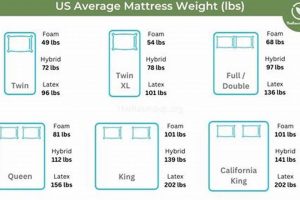
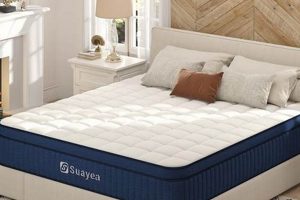
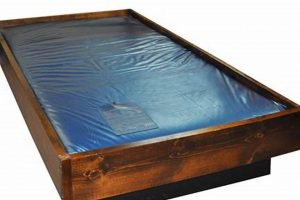
![Best Walmart King Size Blow Up Mattress [Deals!] Organic & Natural Mattress Buyer’s Guide: Non-Toxic Sleep Solutions Best Walmart King Size Blow Up Mattress [Deals!] | Organic & Natural Mattress Buyer’s Guide: Non-Toxic Sleep Solutions](https://mattressworldpa.com/wp-content/uploads/2025/07/th-8177-300x200.jpg)
